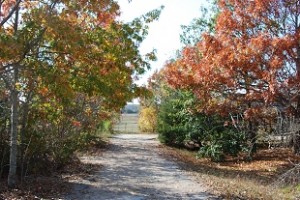For those new to our project (those who haven’t already read about it on my other blogs, where posts about the land are mixed in with other topics) here’s a quick overview. We live on the edge of a small town (literally on the edge–the city limits cuts through our house.) For twenty-two years, the […] [...more]
For those new to our project (those who haven’t already read about it on my other blogs, where posts about the land are mixed in with other topics) here’s a quick overview.
We live on the edge of a small town (literally on the edge–the city limits cuts through our house.) For twenty-two years, the field north of our back garden was someone’s cow pasture, leased to various people, some better managers than others. When it came up for sale, we were in a rare flush period, and bought it (well, we and the bank bought it…) because we’d always hoped it would stay undeveloped. The original field had one corner occupied by a construction company (they have about 10 acres, I think) and a house and yard occupies another half acre.
When we bought it, the person then leasing it was not the best manager…he leased both it and an adjoining, larger place, but overstocked them. Overgrazing had taken its toll; in places, the only vegetation left was what cattle wouldn’t eat, and the nubs were separated by several feet of bare dirt. Dirt that eroded rapidly in every rain.
It’s basically a long skinny rectangle with the long axis roughly east-west, with a notch cut out of one corner of the highway frontage, where the construction company yards are. About three-quarters of the way to the far end, a seasonal creek (dry all year this year) cuts across it, north to south. About ten acres of riparian woods borders the creek and one tiny tributary. Another nine to ten acres of brush tops a low rocky knoll along the north (higher) long side. Originally, it was tall-grass prairie (historical data plus the evidence of old-prairie plants still remnant here and there) but the grass land had been used for cotton first, then corn, then grazing, with some terracing and the planting of “improved” non-native pasture grass and (by one of the earlier managers) winter oats for forage. The original drainage of the main grassland was temporarily changed by a ditch (probably at the time of terracing) leading water from a highway culvert to the south fenceline; years of neglect and trampling by cattle allowed a more natural alternate drainage to form again, but highway runoff dominates that end of the place, including copious runoff from the construction company–turbid with roadbase from their parking lots.
For wildlife management, the existence of varied habitats on one relatively small piece of land is a great help. Winter resident songbirds segregate by preferred habitat–some like the brush, some like the woods, and some like the grassland. The same is true of the breeding bird population in the spring and summer.
Terrain is gentle–there’s only about 20 feet in elevation difference between the highest point and the lowest, and only where former owners gouged out gravel and “road base” from the rocky knoll is there a steep slope (obviously not natural.) Soil varies from solid rock to deep black clay, with areas of brown clay, red gravel, and exposed subsoil (from erosion.) The land is subject to flash floods on the creek (due in part to the rainfall patterns, but also to bad land management upstream that’s led to less permeable soil.)
In eight years, we’ve increased the species count to over 800 (animals and plants) and within taxa counted in the original survey, most have doubled. Though most of the grassland is still dominated by the introduced non-native King Ranch Bluestem (KRB), it’s being invaded by native grasses including meadow dropseed, little bluestem, sideoats grama, white tridens, knotroot bristlegrass, Indiangrass. We’ve also seen the reappearance and spread of original prairie forbs–plants no farmer/rancher in the meantime would have planted, such as Mirabilia alba, four different milkweeds, three different gentians, and many others. We’ve been able to reintroduce some of the original prairie dominants: big bluestem, switchgrass, eastern gama, seep muhly.
Long-term, the plan includes eliminating non-native plants and re-introducing natives missing from the present array. Some re-introductions have been successful and some not. Yet. We use rain-barns to supply water for wildlife and for plantings in the first season (when we collect enough extra water.) Our wildlife management plan, written and carried out to conform to the laws in Texas, requires activity in seven categories (habitat management, provision of supplementary food, water, and shelter, predator control, erosion control, and census.) In addition, the prairie restoration project focuses on maintaining existing “pockets” of original vegetation and increasing the extent of it.
Last year we hosted visits by a nearby Audubon Society group (a bird walk) and a few others interested in specifics, and next year will host a visit by the Texas Native Plant Society (and, no doubt, others.)

